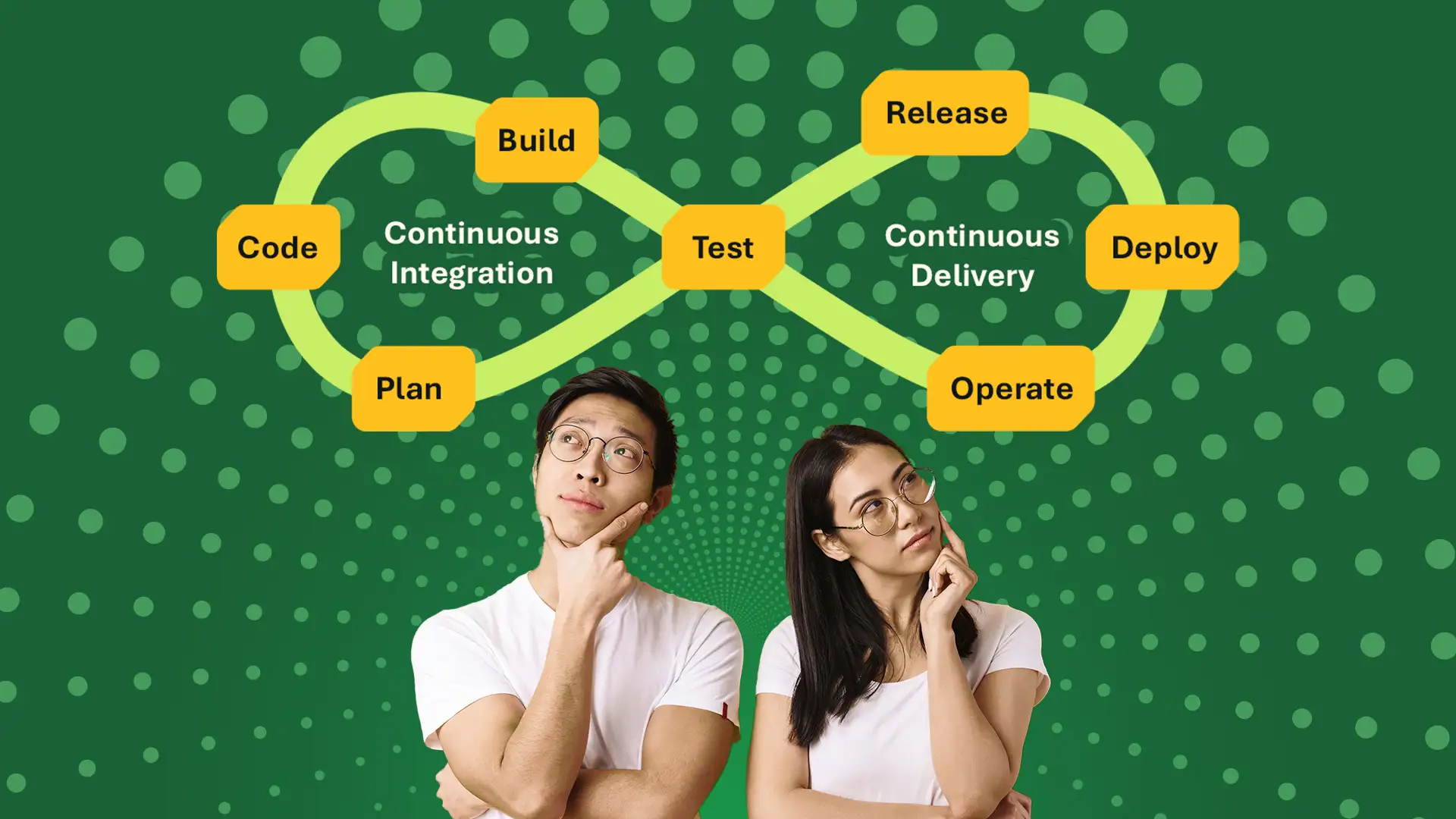Remember the traditional software release cycle? Developers write code for weeks or months, then toss it over the wall to testers, who find bugs, send it back… rinse and repeat. Finally, after nerve-wracking late nights and manual checklists, the operations team attempts a high-stakes deployment, often during off-hours, hoping nothing breaks. This process is slow, risky, stressful, and creates a massive delay between writing code and delivering actual value to customers. CI/CD Explained offers a modern alternative to revolutionize this workflow.
In today’s competitive landscape, businesses can’t afford these bottlenecks. They need to innovate faster, respond quickly to market changes, and deliver reliable software updates seamlessly. This need for speed and stability has driven the adoption of CI/CD – a set of practices and principles that fundamentally transform how software is built, tested, and deployed.
CI/CD isn’t just a technical buzzword; it’s a strategic approach that automates the path from a developer committing code to delivering that value into the hands of your customers. Let’s break down what it means and why it’s essential for modern software development.
What is CI? Continuous Integration Explained
Continuous Integration (CI) is the practice where developers frequently merge their code changes into a central repository (like Git). After each merger, an automated build and automated tests are run.
Think of it like this: Instead of each developer working in isolation for long periods and then facing a painful, complex merger day (“integration hell”), they integrate small changes multiple times a day.
- Frequent Commits: Developers commit code to a shared repository regularly.
- Automated Builds: Every time a code is committed, an automated system compiles the code (if necessary) and builds the software package.
- Automated Testing: Crucially, a suite of automated tests (unit tests, integration tests) runs immediately after the build. These tests verify that the new code didn’t break existing functionality.
Why CI? The Benefits:
- Catch Bugs Early: Running automated tests on every small change means bugs are detected almost immediately, when they are cheapest and easiest to fix. No more hunting for bugs was introduced weeks ago.
- Improve Code Quality: Constant feedback from automated tests encourages developers to write better, more testable code.
- Reduce Integration Problems: Frequent merging avoids the nightmare of integrating large, conflicting changes later in the cycle.
- Increase Visibility: Everyone on the team can see the build status and test results, fostering transparency.
What is a CD? Continuous Delivery vs. Continuous Deployment
CD follows CI and takes automation further down the path to production. It stands for two related but distinct practices:
- Continuous Delivery:
- This practice ensures that after passing all automated CI tests, the software is automatically built, tested further (e.g., acceptance tests, performance tests), and packaged in a way that it could be deployed to production at any time.
- The final step – the actual deployment to the live production environment – still requires manual approval (a push button).
- Why choose this? It gives businesses control over when to release updates to customers, often aligning with marketing schedules, user readiness, or specific business rules, while still ensuring the code is always release-ready.
- Continuous Deployment:
- This is the fully automated version. If the code passes all stages of the automated pipeline (build, unit tests, integration tests, acceptance tests, etc.), it is automatically deployed directly into production without any human intervention.
- Why choose this? It maximizes release speed, delivering new features and fixes to users as soon as they are ready. This requires a high degree of confidence in automated testing and monitoring processes.
The Key Difference: Continuous Delivery means the software can be deployed manually at any time; Continuous Deployment means it is deployed automatically if it passes all checks. Many organizations start with Continuous Delivery and may evolve to Continuous Deployment as their confidence in automation grows.
The CI/CD Pipeline: An Automated Assembly Line
Think of the entire CI/CD process as an automated assembly line for your software. Code enters at one end, and deployable (or deployed) software comes out the other, passing through various quality gates along the way. A typical pipeline includes stages like:
- Commit/Source: A developer commits code changes to the version control repository (e.g., Git). This triggers the pipeline.
- Build: The automated system compiles the code and creates deployable artifacts (e.g., executable files, container images).
- Test: Automated tests run at various levels:
- Unit Tests: Verify individual code components.
- Integration Tests: Check if different components work together correctly.
- Acceptance Tests: Validate if the software meets business requirements.
- (Optional) Performance Tests, Security Scans, etc.
- Deploy:
- (Continuous Delivery): The verified build is automatically deployed to staging/UAT environments. A manual trigger deploys it to production.
- (Continuous Deployment): The verified build is automatically deployed through various environments (like staging) and finally into production.
- Monitor (Implicit): While not always at a distinct pipeline stage, continuous monitoring of the application in production is crucial to detect issues quickly after deployment.
If any stage fails (e.g., a test fails; the build breaks), the pipeline stops, and the team is immediately notified. This prevents faulty code from progressing further.
Why CI/CD Matters: The Tangible Business Value
Implementing CI/CD isn’t just about adopting new tools; it’s about driving significant business outcomes:
- Dramatically Faster Time-to-Market: Automating the build, test, and deployment process allows you to release new features, bug fixes, and updates to your customers much more frequently and predictably. This is a huge competitive advantage.
- Reduced Deployment Risk: Automation eliminates manual errors. Rigorous automated testing catches issues before they reach production. Rollbacks (if needed) become easier and faster when dealing with smaller, incremental changes.
- Improved Developer Productivity & Happiness: Developers spend less time on manual build/test/deploy tasks and debugging integration issues, freeing them up to focus on writing valuable code. Faster feedback loops and less release-day stress boost morale.
- Faster Feedback Loops: Releasing smaller changes more often allows you to get user feedback quickly and iterate based on real-world usage, ensuring you’re building what customers actually need.
- Increased Reliability and Quality: Consistent automated testing and deployment processes lead to higher quality software with fewer production defects.
- Lower Costs: Fewer bugs reaching production, reduced manual effort, and less time spent fixing broken deployments all contribute to significant cost savings.
- Enhanced Customer Satisfaction: Customers benefit from receiving new features faster and experiencing a more stable, reliable application.
Key Components Powering CI/CD
A robust CI/CD pipeline typically involves several types of tools working together:
- Version Control System (VCS): The foundation (e.g., Git).
- CI/CD Server/Platform: The orchestrator (e.g., Jenkins, GitLab CI/CD, Azure DevOps Pipelines, GitHub Actions, CircleCI).
- Build Tools: Compile code and package applications (e.g., Maven, Gradle, npm, Docker).
- Testing Frameworks: Automate various types of tests (e.g., JUnit, NUnit, Selenium, Cypress).
- Artifact Repository: Store built artifacts (e.g., Nexus, Artifactory, Docker Hub).
- Deployment Tools/Strategies: Manage deployment to servers or cloud platforms (e.g., Ansible, Kubernetes, Serverless frameworks, cloud provider deployment services).
- Monitoring & Logging Tools: Observe application health post-deployment (e.g., Prometheus, Grafana, Datadog, ELK Stack).
More Than Just Tools: A Cultural Shift
Successfully implementing CI/CD requires more than just installing software. It often involves a cultural shift towards:
- Collaboration: Breaking down silos between development, testing, and operations.
- Automation Mindset: Prioritizing automation for repetitive tasks.
- Shared Responsibility: Teams taking ownership of the entire software lifecycle.
- Continuous Improvement: Regularly reviewing and refining the pipeline and processes.
Conclusion: Your Automated Bridge to Value
CI/CD transforms the software delivery lifecycle from a slow, risky, manual process into a fast, reliable, automated pipeline. It acts as a bridge, efficiently and safely carrying code changes from a developer commitment all the way to delivering tangible value to your customers. By embracing Continuous Integration and Continuous Delivery/Deployment, organizations can significantly accelerate innovation, improve software quality, reduce operational overhead, and ultimately gain a critical edge in today’s demanding market. It’s no longer a luxury; it’s a necessity for modern software development.
Ready to Build Your CI/CD Pipeline?
Implementing an effective CI/CD strategy requires careful planning, the right tools, and expertise in automation and DevOps practices. At Clink IT Solutions, we help businesses design and build robust CI/CD pipelines tailored to their technology stack and business goals.
We can assist with:
- Assessing your current processes and identifying automation opportunities.
- Selecting and configuring the right CI/CD tools.
- Building automated build, test, and deployment workflows.
- Integrating security scanning (DevSecOps) into your pipeline.
- Training your teams in CI/CD best practices.
Automate your path to faster, safer software delivery. Let’s discuss how CI/CD can accelerate your development lifecycle and deliver more value faster.



